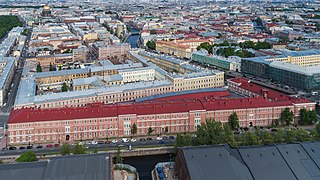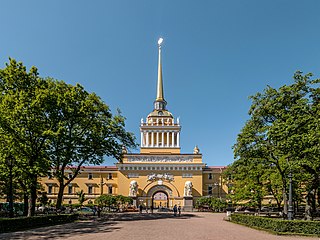
Peter I, was Tsar of all Russia from 1682, and the first Emperor of all Russia, known as Peter the Great, from 1721 until his death in 1725. He reigned jointly with his half-brother Ivan V until 1696. From this year, Peter was an absolute monarch, an autocrat who remained the ultimate authority and organized a well-ordered police state.

The Moscow Kremlin, or simply the Kremlin, is a fortified complex in Moscow, Russia. Located in the centre of the country's capital city, it is the best known of the kremlins and includes five palaces, four cathedrals, and the enclosing Kremlin Wall along with the Kremlin towers. Within the complex is the Grand Kremlin Palace, which served as the royal residence of the Emperor of Russia. It is now the official residence of the President of the Russian Federation. The Kremlin overlooks the Moskva River to the south, Saint Basil's Cathedral and Red Square to the east, and Alexander Garden to the west.

The Grand Kremlin Palace is a building in the Moscow Kremlin. For much of the 19th century, it served as the official residence of the Russian emperor in Moscow. Designed by a team of architects under the management of Konstantin Thon, the palace was intended to emphasise the greatness of Russian autocracy.

The Palace of the Facets is a building in the Moscow Kremlin, Russia, which contains what used to be the main banquet reception hall of the Russian tsars. It is the oldest preserved secular building in Moscow. Located on Kremlin Cathedral Square, between the Cathedral of the Annunciation and the Dormition Cathedral. Currently, it is an official ceremonial hall in the residence of the President of the Russian Federation and thus admission is limited to prearranged tours only.

Count Fyodor Matveyevich Apraksin was one of the first Russian admirals, governed Estonia and Karelia from 1712 to 1723, was made general admiral (1708), presided over the Russian Admiralty from 1717 to 1728 and commanded the Baltic Fleet from 1723.

Konstantin Andreyevich Thon, also spelled Ton was an official architect of Imperial Russia during the reign of Nicholas I. His major works include the Cathedral of Christ the Saviour, the Grand Kremlin Palace and the Kremlin Armoury in Moscow.

The city of Saint Petersburg was founded by Tsar Peter the Great on 27 May 1703. It became the capital of the Russian Empire and remained as such for more than two hundred years. Saint Petersburg ceased being the capital in 1918 after the October Coup.

The Church Reform of Peter the Great was a set of changes Tsar Peter I introduced to the Russian Orthodox Church, especially to church government. Issued in the context of Peter's overall westernizing reform programme, it replaced the Patriarch of Moscow with the Holy Synod and made the church effectively a department of state.

Central Naval Museum is a naval museum in St Petersburg, Russia, reflecting the development of Russian naval traditions and the history of the Russian Navy. The museum’s permanent display includes such relics as the Botik of Peter the Great, Catherine II’s marine throne, trophies captured in sea battles, and the personal belongings of prominent Russian and Soviet naval commanders. The collection includes paintings by Ivan Aivazovsky, Alexey Bogolyubov, Lev Lagorio and other marine artists, ship sculpture, navigational instruments, naval equipment and machinery from the 17th to 20th centuries and numerous models of ships.

Izmaylovo District is a district in the Eastern Administrative Okrug of the federal city of Moscow, Russia. Population: 102,837 (2010 Russian census); 110,099 (2002 Census).

The coronation of the emperor of Russia from 1547 to 1917, was a highly developed religious ceremony in which they are crowned and invested with regalia, then anointed with chrism and formally blessed by the church to commence his reign. Although rulers of Muscovy had been crowned prior to the reign of Ivan III, their coronation rituals assumed overt Byzantine overtones as the result of the influence of Ivan's wife Sophia Paleologue, and the imperial ambitions of his grandson, Ivan the Terrible. The modern coronation, introducing "Western European-style" elements, replaced the previous "crowning" ceremony and was first used for Catherine I in 1724. Since tsarist Russia claimed to be the "Third Rome" and the replacement of Byzantium as the true Christian state, the Russian rite was designed to link its rulers and prerogatives to those of the so-called "Second Rome" (Constantinople).

Saint Petersburg, formerly known as Petrograd and later Leningrad, is the second-largest city in Russia after Moscow. It is situated on the River Neva, at the head of the Gulf of Finland on the Baltic Sea. The city had a population of 5,601,911 residents as of 2021, with more than 6.4 million people living in the metropolitan area. Saint Petersburg is the fourth-most populous city in Europe, the most populous city on the Baltic Sea, and the world's northernmost city of more than 1 million residents. As Russia's Imperial capital, and a historically strategic port, it is governed as a federal city.

The Naval Cadet Corps, occasionally translated as the Marine Cadet Corps or the Sea Cadet Corps, is an educational establishment for educating naval officers for commissioning in the Russian Navy in Saint Petersburg.

The Admiralty building is the former headquarters of the Admiralty Board and the Imperial Russian Navy in Central St. Petersburg, Russia and the current headquarters of the Russian Navy.

The emperor and autocrat of all Russia, also translated as emperor and autocrat of all the Russias, was the official title of the Russian monarch from 1721 to 1917.

Day of the Russian Navy is national holiday in the Russian Federation and a senior holiday in the Russian Armed Forces. The day honors the sailors in units of the Russian Navy and its specialized arms. It is celebrated annually, on the last Sunday of July.

Saint Petersburg – second-largest city in Russia. An important Russian port on the Baltic Sea, it has the status of a federal subject. Its name was changed to "Petrograd" in 1914, then to "Leningrad" in 1924, and back to Saint Petersburg in 1991.

Alexander Nevsky Square, formerly called Red Square, is a city square in Tsentralny District, Saint Petersburg. It is at the east end of Nevsky Prospekt, linking the street with the Alexander Nevsky Lavra.






















